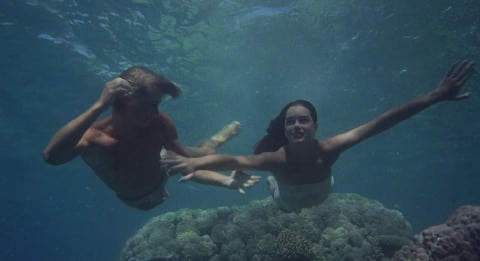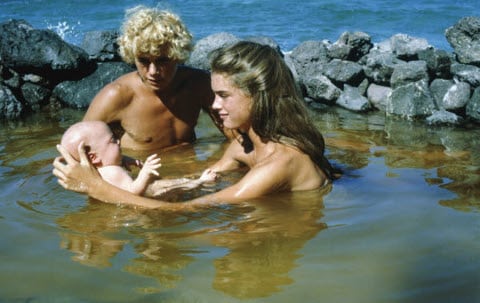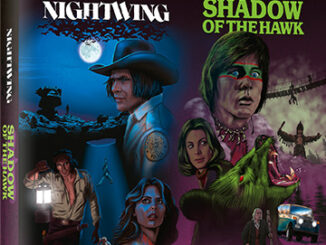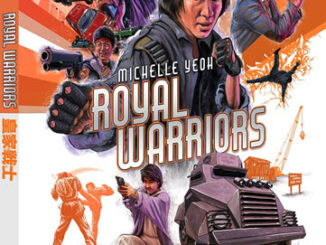The Blue Lagoon (1980)
Directed by: Randal Kleiser
Written by: Douglas Day Stewart, Henry De Vere Stacpoole
Starring: Brooke Shields, Christopher Atkins, Leo McKern, Paddy Button
USA
ON DUAL FORMAT BLU-RAY AND DVD: 10th April, from EUREKA ENTERTAINMENT
RUNNING TIME: 104 min
REVIEWED BY: Dr Lenera, Official HCF Critic
In the Victorian period, two young child cousins, Richard and Emmeline Lestrange, and a galley cook, Paddy Button, are thrown together when their ship catches fire and everyone has to abandon. Initially lost in the South Pacific, they reach a lush tropical island. Paddy cares for the small children and forbids them by ‘law’ from going to the other side of the island, as he found remains from bloody human sacrifices. Paddy dies after a drunken binge, and his body is discovered by Richard and Emmeline. Now alone, the children go to another part of the island and rebuild their home. Years pass and they both grow into teenagers and begin to fall in love, although this is emotionally stressful for them because of their lack of education….
Twice I almost reviewed The Blue Lagoon as a ‘HCF Guilty Pleasure’, a film that we know isn’t actually too good but that we can’t help but enjoy. King Kong Lives is the most recent one that I did. I don’t know why I changed my mind on doing The Blue Lagoon on those two occasions, but here I am reviewing it now because it’s just about to come out on Blu-ray from Eureka Entertainment – and while I was watching it yet again for the purposes of this review, my supposedly much more critical eye didn’t really reveal much in the way of more flaws – in fact as I type I wonder if I was mistaken in considering reviewing it as a ‘Guilty Pleasure’ in the first place. It was critically slated when it came out, but has a lot of fans, and I genuinely think it’s as almost as good a movie as I did when I first saw it and was one of thousands of teenage boys who thought that the idea of being stranded on an island with Brooke Shields was the most wonderful concept in the world. I suppose it partly depends on your attitude to things like realism. Yes, it’s an often absurd and certainly unbelievable story, but I’ve always taken the film more as a heavily idealised view of adolescence and young love, almost a kind of fairy tale. And it’s often a genuinely beautiful movie, stunningly shot and unashamedly romantic, which for me goes a long way to make up for the fact that – yes – the acting is often quite poor, though I honestly don’t think it’s quite as bad as all that, especially considering how Christopher Atkins had never acted in anything before, and how difficult it must have been for two young people to play certain scenes.
It was adapted from a 1908 novel by Henry De Vere Stacpoole of the same title which spawned two sequels from the same writer. There was a now lost silent screen version in 1923 and a 1949 remake which seems considered to be quite good though for some reason has never been available on video or DVD. I once had a copy on tape recorded from TV and accidently taped over it before I’d even watched it. Initiated by screenwriter Douglas Day Stewart who stuck quite closely to the book though hugely expanded the section where the kids ‘changed’, the project was turned down by most of the Hollywood studios before Columbia picked it up. The director was Grease’s Randal Kleiser. The original idea was to have the teenage Richard and Emmeline always in the nude, which was largely why many stars including John Travolta, Lori Laughlin, Debra Winger, Isabelle Adjani, Richard Gere and initially Brooke Shields, who was actually the first choise for Emmeline, turned the film down. Jennifer Jason Leigh was almost Emmeline but her father made her refuse the part. William Aames and Diane Lane almost did it but changed their minds two days before shooting. The desperate Kleiser finally agreed to let 14 year old Shields star predominantly clothed, with her hair taped to her breasts and, as she testified before a US Congressional enquiry, body doubles employed for the nude scenes. 18 year old Christopher Atkins was selected from the audition tapes. Shot in Jamaica but mostly on a private island in Fiji called Manuya Levu where a new species of iguana was accidently discovered, with underwater scenes at Comino Island in Malta, The Blue Lagoon was a major hit despite its ridiculously negative critical reception. 1991’s mediocre Return To The Blue Lagoon failed to repeat this film’s success.
I guess many new viewers wouldn’t like the moment where Paddy catches Richard and Emmeline looking at his nudie pictures, smacks Richard, and is about to smack Emmeline before the fire on the ship begins. They barely know each other and poor Emmeline’s parents are dead. Paddy’s actually as cliched a sailor as you can get, with seven wives and kids in every port, and given to making up stuff like saying that the sun hisses when it touches the water. The powerful imagination that children have allows the two to think that they actually hear this, though when they’re older they all-but-realise it was porkies – yet still tell it to their child. Reaching as glorious a tropical island as you think of, Emmeline nearly swallows a berry Paddy calls a “never wake up berry”, and warns them never to go over to the other side of the island. The fact that the kids are never seen by the cannibals who don’t live that far away is undoubtedly ridiculous, but this subplot has an ironic development when a large stone statue where blood sacrifices have been made is considered by Emmeline – who even presents flowers to it – a clever indication of the innocence of the two and how something symbolic of horrible stuff can be something completely different to others. It’s not long in the film before we get the first of several lengthy montages which propel things forward, and in which Basil Poledouris’s divine score is allowed to really dominate, this one showing Paddy teaching the kids how to survive, something which comes in handy when Paddy is found mysteriously dead after having gotten himself very drunk from a barrel of rum conveniently lying around. In truth, it is pretty unbelievable that they make it into adulthood, usually look so clean and well groomed, and live in an elaborate two story abode by the sea. And I’ve still never worked out where many of their clothes come from.
Anyway, the two bicker and even row while gradually falling for each other. I remember critics mocking such lines as: “I just keep on having all these strange thoughts” and “Why are all these hairs growing on me”? But, for God’s sake, that is probably what they would have said as they’ve had no education in these matters. And it’s no surprise that they eventually end up having sex all over the island. This film was considered to be exploitative by many when it came out, but in fact the sexual content is discreetly handled. We don’t even see Shields topless as I mentioned before, the shots of the breasts of her doubles are very brief, and Kleiser is clearly more interested in Atkin’s body anyway. How much better it would have been for a teenager in 1980 to watch a sensitively handled film like this than one of the many dire raunch comedies of the time! Of course the two end up having a baby in one of the cleanest, least taxing births in cinema history [she doesn’t even break into a sweat], and the contrivances required to set things up for the tragic [or is it tragic, you have to decide, I’ve always thought it is] are maybe a little silly, though they’re in the book too, and there are some extremely poignant moments too. Early on it’s decided that whoever sees a ship shall light a fire on a hill. A bit later, Emmeline sees a ship but hesitates to do anything, being used to her life now. And then much later, the two are having fun with their child smearing themselves in wet sand and are spied by a ship headed by their uncle Arthur who’s still looking for them. The boy points out “boat”, but Richard and Emmeline head quickly for the forest. This island is now their home, and they are now in a way savages. Does Arthur somehow recognise them when he sees them before saying “No, it couldn’t be them” and ordering the ship to move on?. I’ve often thought that he does.
Glenn Kohan and Elva Josephson, who play the very young Richard and Emmeline, do seem more natural than their older counterparts. And yet the awkwardness of Atkins and Shields doesn’t for me hamper things too much, and what many critics considered to be bad dialogue is actually very appropriate and clearly intentional. After all, these are young adults who were cut off from the rest of the world at a very young age, and who therefore end up with the limited education, mentality, vocabulary and speech of 8 year olds. I find it absolutely astonishing how no review I’ve ever read of this film mentioned this, it obviously never having occured to the reviewer. Every now and again Kleiser will cut to one of several stereo optic slides that the two have representing typical Victorian decorum, emphasising the naturalness and innocence of their love. He also loves to cut to wildlife extremely often, but then this film is also a general celebration of nature and this adds to the extreme visual beauty of The Blue Lagoon where so much of the story telling is done visually anyway. In many ways the real two stars of the film are cinematographer Nestor Almendros and composer Basil Poledouris. Aldmendros, mostly using natural light and shooting many scenes at ‘magic hour’ for maximum effect, lovingly lenses the tropical island of our imagination, the beaches, the forests, and the underwater scenes combining to form a true paradise, an Eden of sorts [well, there are certainly are Biblical parallels in the story though they don’t tend to be ‘in your face’]. An attempt to photograph Emmeline swimming amongst phospherescent plankton at night didn’t work out but the scene as filmed with special lenses is still strikingly lovely. And the music, with several lovely themes recurring throughout, is full of heart, interesting harmonies, a sense of genuine innocence and later nostalgia, without ever feeling schmaltzy. Editor Robert Gordon also deserves a bow for his skill during the many montages which are superbly put together and are some of the loveliest parts of the film, being just so relaxing and soothing to watch.
I reckon that every film fan has some movies which they love and which they consider that the critics just didn’t ‘get’. I do think that this film’s reputation has increased a little, but it’s never going to be widely re-accessed as a quality product. The Blue Lagoon, with its escapist nature and fanciful beauty, somehow spoke to me as a teenager [as it obviously did many others] far more than many of the better regarded teen-aimed films of the time, and I immediately fell in love with it. Now, of course certain flaws are very obvious so I can’t rate it too highly, and I have the feeling that many first time modern viewers will find it hard to swallow because we tend to live in a time where a tale like this would have to feel more grounded [though they’d probably be an uproar if the two main characters were still under 18 anyway], but I’ll still continue to defend this movie anyway. For us fans, it pulls us away from modern life and takes us back in time to a paradise where we’re shown the growing up process and love in their most primitive, yet perhaps also their purest, form. And if you still consider it to be a bad movie, check out the horrible and truly stupid 2012 semi-remake. Now that’s a bad movie.
Rating: 









Using the same 4k master as Twilight Time’s Region ‘A’ list, Eureka have treated us fans of The Blue Lagoon with an absolutely gorgeous looking release of a film in which the visual aspect is so important. The varied colour palette is perfectly presented with the exact amount of saturation, and even close-ups reveal a huge amount of detail. The level of filmic grain is just right too. While even the DVD of the film looked pretty good, I was blown away by this presentation. Eureka have ported over the Twilight Time extras, which were in turn taken from the old DVD except for the music and effects track. I remembered both audio commentaries to be good, and they were certainly worth listening to again. Kleiser and Stewart rarely come up for air, sometimes talking very fast as they try to cram in every bit of information about the film as they can think of. Right from the offset we get some great stories [the model ship falling over just as they were about to blow it up] and as much background detail as you can wish. Shields turns up about half an hour in and seems to enjoy reminiscing. Kleiser made her and Atkins live together so they got to know each other! The second commentary has Kleiser and Atkins. It takes a while to warm up with Kleiser tending to repeat things he’d said on the other commentary but does get better and better, Atkins relating some great tales of his own [the shoot in Fiji brought two warring tribes together to make peace] and states several times that the filming was a life-changing experience. He’s also quite frank about what it was like to film the love scenes. The shoot in Fiji really sounds like an adventure. Finally there’s a really ropey looking featurette from 1980 that has some nice but all-too-brief behind the scenes stuff. None of the stuff apart from the music and effects track is new, but fans will still want these valuable commentaries, at least, preserved on Blu-ray and newcomers should find them fascinating. My thanks to Eureka for bringing to Region ‘B’ Blu-ray a much maligned film which has been a personal favourite of mine for around 25 years, and which will now hopefully garner some new fans.
SPECIAL FEATURES
*Stunning High-Definition Presentation
*Isolated music and effects track
*Audio Commentary featuring Randal Kleiser, Douglas Day Stewart and Brooke Shields
*Audio Commentary featuring Randal Kleiser and Christopher Atkins
*An Adventure in Filmmaking – a behind the scenes featurette on the making of the film
*Original theatrical trailer








Be the first to comment